Drive our nation’s highways and you’ll see hazardous materials in transportation. Drive on some of the main transportation corridors – like Interstate 80 (I-80) – and you’ll see some very interesting HazMat transported in commerce.
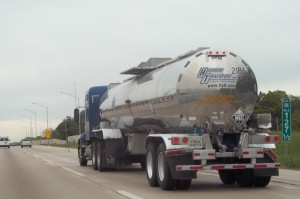
And if you’re like me, you want to know what it is being transported in the vehicles you see on the highway. Like this one.
First of all, the vehicle is a cargo tank motor vehicle (defined at 49 CFR 171.8), which means it is permanently attached – or nearly so – to a bulk packaging tank.
But what’s in the cargo tank? Well, the placards – displayed on each side and each end per 49 CFR 172.504(a) – indicate the HazMat is a Class 8 Corrosive Material. A Class 8 could be a solid, but given that a cargo tank is intended primarily for liquids or gases I’m going to assume for now that the contents are a liquid; further research will prove this assumption correct.
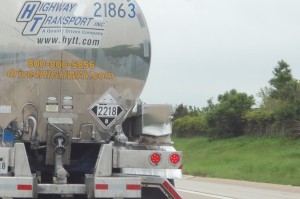
Since this is a bulk packaging, it is required to display the HazMat’s identification number on all four sides on or in association with the placards. The identification number for this HazMat is 2218.
Using the yellow pages of the 2012 Emergency Response Guidebook I find that the identification number 2218 corresponds with a proper shipping name of Acrylic acid, stabilized, which is found in the Hazardous Materials Table at 49 CFR 172.101:
What information can I glean from the Hazardous Materials Table entry? Plenty, if I take the time to dig into the regulations which I’m not going to do here. But… 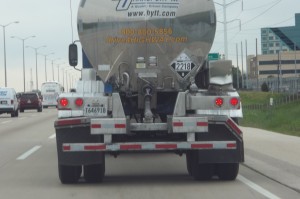
- Column 5 indicates its packing group is II, which represents a “moderate” degree of danger.
- The Special Provisions of column 7 include restrictions on the types of packagings that may be used, e.g. “MC 300, MC 301, MC 302, MC 303, MC 305, and MC 306 and DOT 406 cargo tanks are not authorized.”
- Column 8A indicates the section (154) of part 173 of the Hazardous Material Regulations (HMR) to research for any possible packaging exceptions applicable to Acrylic acid, stabilized. There are none for a packaging of this size.
- Columns 8B and 8C indicate the sections (202 for non-bulk and 243 for bulk, respectively) of part 173 to reference in determining the authorized packaging for this HazMat. 49 CFR 173.243 limits an authorized cargo tank motor vehicle to one of the following: Specification MC 304, MC 307, MC 330, MC 331 and MC 310, MC 311, MC 312, DOT 407, and DOT 412 with tank design pressure of at least 172.4 kPa. In addition – I learn from 49 CFR 173.243 – the cargo tank must have a specified pressure relief system and bottom outlets.
- Column 9A tells me this HazMat as cargo on a passenger-carrying aircraft is limited to no more than 1 liter/package while column 9B indicates the Acrylic acid, stabilized can be as much as 30 liters/package if transported as cargo on a cargo-only aircraft.
- Column 10 sets stowage requirement applicable only if the HazMat is transported by vessel over water.
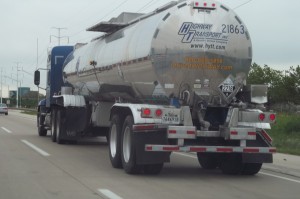 There is one more interesting thing I learn from column 6 of the Hazardous Materials Table: Acrylic acid, stabilized has a primary hazard of Class 8 Corrosive Material and a subsidiary hazard of a Class 3 Flammable Liquid. And while a non-bulk packaging of this HazMat is required to display both the primary (Corrosive) and subsidiary (Flammable Liquid) HazMat labels, the cargo tank is not displaying Flammable Liquid placards. Why not? Because pursuant to 49 CFR 172.505 only the following HazMat require the display of placards when present as a subsidiary hazard:
There is one more interesting thing I learn from column 6 of the Hazardous Materials Table: Acrylic acid, stabilized has a primary hazard of Class 8 Corrosive Material and a subsidiary hazard of a Class 3 Flammable Liquid. And while a non-bulk packaging of this HazMat is required to display both the primary (Corrosive) and subsidiary (Flammable Liquid) HazMat labels, the cargo tank is not displaying Flammable Liquid placards. Why not? Because pursuant to 49 CFR 172.505 only the following HazMat require the display of placards when present as a subsidiary hazard:
- Class 7 Radioactive
- Division 4.3 Dangerous When Wet
- Division 6.1 Poison that is a Poison Inhalation Hazard or a Division 2.3 Poison Gas
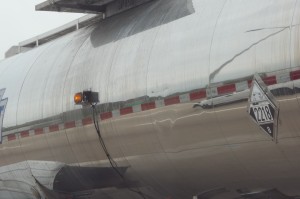
Keep your eyes open. Watch for HazMat on the highway. And use the available hazard communication methods to determine what those vehicles are transporting.
And, as always, don’t hesitate to contact me with any questions.
Contact me with any questions you may have about the transportation of hazardous materials by air, highway, vessel, or rail International and Domestic Daniels Training Services 815.821.1550 |

